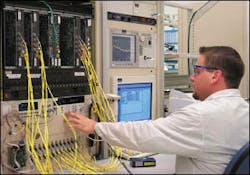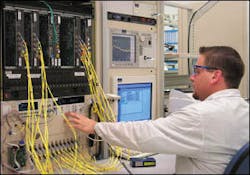Production - From prototype to production: what the right manufacturing partner can offer OEMs
In today's competitive market, getting the product out the door is critical. An outsource manufacturer can provide the production know-how your company needs to stay on the fast track.
MOEZ ADATIA, Iphotonics Inc.
Rapid technological change, sluggish network utilization, and an economic slowdown are challenging the business strategies of most fiber-optic broadband equipment companies. The increased competition in this climate is leading many equipment vendors to devote their resources to core strengths such as the design, development, and marketing of their products.
Despite the downturn, product lifecycles continue to be slashed, causing original equipment manufacturers (OEMs) to work diligently to cut time-to-market. The longer it takes to get a product to market, the more money that's needed for salaries, overhead, and prototypes. Development costs rise, and market share erodes. This dilemma is compounded as capital sources take a harder look at the industry and in some cases dry up. Optical-networking equipment vendors must generate profits sooner than previously anticipated. Getting products to market on time is the most important factor affecting profitability. In light of recent developments, many OEMs are beginning to recognize that it makes sense to outsource the manufacturing of their subsystems and module designs.
An entire industry of contract manufacturing has already grown up and matured in the electronics business. Many of these same semiconductor contract manufacturers, with grounding in the electronics field, are now rushing into the optics market. But the very nature of optical assembly and manufacturing goes against the automated high-volume business model of traditional electronic contract manufacturers.
Some optical-component manufacturers also see opportunities in assembly and manufacturing and are attempting to provide this additional service to their OEM customers. Conflict-of-interest issues may arise, however. Can a brand-loyal component manufacturer truly have the best interests of the customer in mind, particularly when it is involved at the design stage? And how does any manufacturing partner assure a client of proprietary design protection?
The challenge is to create a business model that provides proper levels of support to the OEMs for the integration and manufacturing of optical modules and subsystems, while protecting proprietary design innovations. Although system developers are the focus here, component developers and others allied to this field are also looking to outsource their manufacturing, and these companies face the same concerns of balancing design, manufacturing, and intellectual property issues.Outsourcing is not subcontracting. Outsourcing is an organization's long-term strategy to maximize its assets, including capital, personnel, and other resources. The outsourcing partner is, in effect, an extension of the OEM's own manufacturing process, freeing the equipment company from concerns about product delivery, quality, or the sharing of proprietary information.
OEMs should evaluate a potential outsourcing partner's understanding of end-user needs and process flow as well as their strategic growth plans, especially technology strategies to keep up with market direction. The outsourcing partner's personnel should demonstrate a solid knowledge of both optical integration and manufacturing. The potential partner should have access to an infrastructure of the most advanced manufacturing and testing equipment. Design engineering services that support new-product introductions from prototype to production must be in place.
Ideally, the partnership begins at the concept stage. Very early involvement in the conceptual and prototype stages allows the partner to work with the OEM to consider manufacturing processes during the engineering of a particular design and establish the shortest possible time to production volume. Valuable input into the next generation of products from a manufacturing point of view also helps the customer achieve optimum cost advantages, volume outputs, and superior product performance in the long term.
Prototype-to-volume production of optical subsystems requires more than simply acquiring a piece of equipment to perform a particular function. Virtually all subsystem requirements are tailored to specific outputs and functions. The outsourcing partner's knowledge of the best equipment to accommodate the manufacturing of a specific subsystem or module will not only expedite the outcome, but also this expertise can assure the quality desired by the customer. In some cases, software-driven test platforms and equipment must communicate with one another, and considerable tweaking, tuning, and design work is necessary to achieve this goal.
While a variety of systems designed for specific functions such as component testing are available off-the-shelf, that is not the case for test platforms that perform multiple functions, especially those tailored to fit a customer's optical parameters. Custom building and manufacturing of optical subassemblies requires the ability to test a variety of product lines, often in volume. These cases call for specially developed software and test systems configured for automated volume testing. This type of highly specialized testing equipment is rarely available in the marketplace. The challenge comes down to making advanced equipment match each customer's proprietary test regime. And very few companies have the depth of knowledge to do this efficiently.
A real-time, interactive system enabling conferencing, data acquisition, and computer-aided design (CAD) among all the manufacturing participants is critical. For example, metro optical equipment supplier ONI Systems uses videoconferencing to enable anyone in any office to debug problems in the assembly process. This shared information system effectively turns the outsourcing partner into a direct extension of the OEM. It also integrates procurement, manufacturing, and testing with the customer's enterprise resource planning (ERP) and manufacturing systems databases.
There is no single tool that provides this "virtual" manufacturing capability. It is built from the ground up. Various means, such as a T1 line and other Internet solutions, can be used to create Web-enabled virtual private networks that allow real-time data acquisition. Firewalls and other security measures such as password constraints are of course necessary.
With this type of a system, each partner can dial into the other's site in real time. As the outsourcing partner tests circuit packs on the floor, the data is transmitted to the other party. Yield analysis can also be performed and managed in real time. The customer can click on a circuit pack to learn which tests are being performed, view the first-pass yield, the second-pass yield, and in the event of a failure determine why. Geography is no longer a factor.
This type of information in real time provides more reaction time during the preliminary testing stages, rather than when the product is leaving the loading dock. It also frees up the customer's shop floor and testing stations for new-product lines.
Outsourcing partners must retain people fully trained in fiber management and handling who understand testing and engineering and who can provide feedback on an assembly unit as it moves from prototype to production. Expertise and a bias toward action are critical in the production process. Anyone can follow instructions and assemble components. But not everyone can test, troubleshoot, and provide feedback backed by solid manufacturing engineering support.
A proactive company culture encourages looking beyond the initial assembly instructions to recommending and creating processes that enable more efficient and reliable results. The outsourcing partner shouldn't wait for the customer to come up with suggestions; its employees should be able to anticipate issues and provide solutions.
A mutually beneficial relationship involves a great deal of sustaining engineering. To offer meaningful suggestions to the OEM or component developer, the manufacturing partner must not only understand the current product line, but also have keen insight and ability to project what the next generation of products will require from a manufacturing and testing point of view. Going beyond that, a depth of knowledge that facilitates an accurate view and understanding of where the client is currently positioned in the market and where it desires to end up is important. In that sense, the customer's success is tied to that of its chosen partner.
The trend toward outsourcing the manufacturing of optical components continues to grow. As a result, established and startup companies are looking at the outsourcing business as an opportunity. That should raise a red flag for vendors seeking a manufacturing partner. The reason companies are outsourcing their manufacturing in the first place is because it's not the best use of their resources (these vendors want to find a manufacturing partner with competency in the fiber-optic domain.
Just how competent are these outsource companies? If the company isn't already involved in fiber-optic assembly, forget it. An OEM doesn't have the time or resources to train an outsourcing partner. What is their level of expertise in the optical field? Optical is different than electrical, and optical experience is critically important.
What level of test complexity can the outsourcing partner perform? Testing is key to quality control and volume production. What about systems and software to manage materials, orders, and process flow? That is a good indication of sophistication and capabilities for volume production.
Compatible corporate cultures and business models, along with the mutual desire for a long-term commitment, can provide a solid foundation for outsourcing relationships. That allows the "outsourcers" to focus on their core competencies: research and development, product design, and marketing. These activities grow and strengthen a business and keep it thriving during tough economic times.
Moez Adatia is vice president of Iphotonics Inc. (Glen Burnie, MD). He can be reached via the company's Website, www.iphotonics.com.

